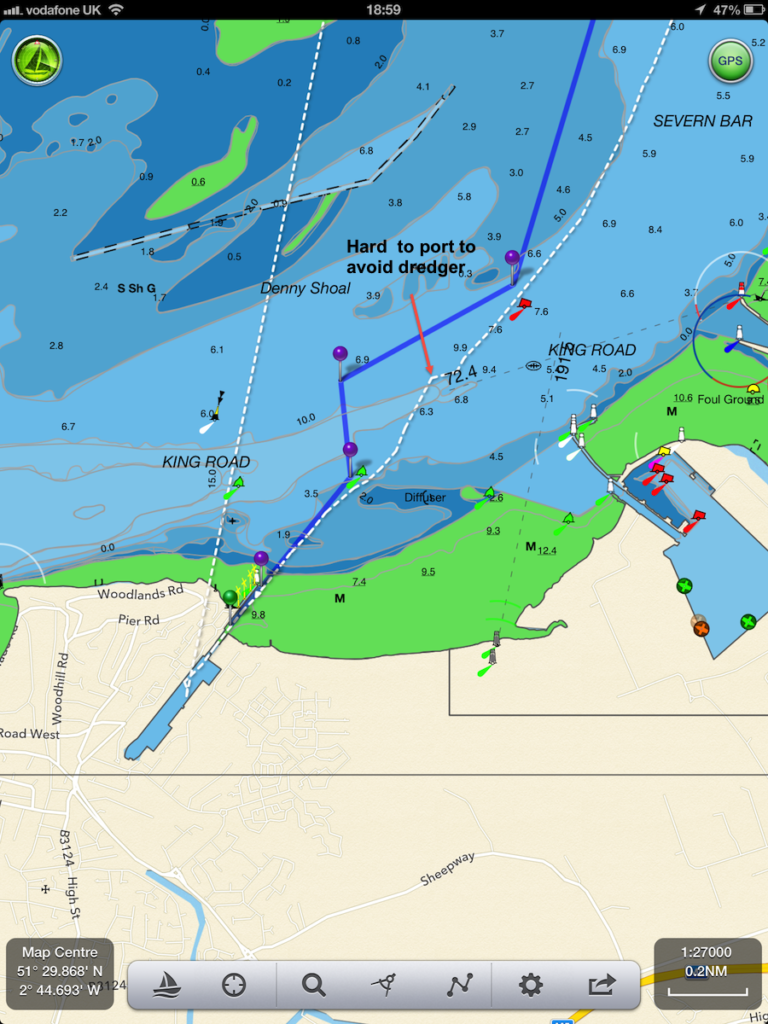
Sea Trials – Sailing with SeaNav, Boat Beacon and Boat Watch – Day 2


We took Sarita, my 27′ catamaran out to test the latest versions of SeaNav and Boat Beacon at sea in the Bristol Channel. The planned route was a 6 hour passage on the ebb tide from Chepstow to Cardiff (see SeaNav route plan below). 3 persons on board; Captain Keith Avery of the RSS Discovery ( see the excerpt from Sarah Casey’s book – the Wave ) , our Vicar, also an ex-merchant navy officer and myself. Illustrious company.
The trip went well and to plan until we were just off Portishead where strong wind against tide made the going very uncomfortable and slow. As we didn’t have to get to Cardiff that day we decided to stop over in Portishead. Boat Beacon transmitted our position faithfully and my family tracked our progress live on our Boat Watch app and the web ( http://boatbeaconapp.com/go/MMSI ). Captain Avery helmed most of the way and was impressed with our apps. Check the screenshots below for the route, track and web views. The blue line and pins are the planned route and waypoints, the white dotted line is the recorded track. You can see the exact pontoon we tied Sarita up at in Portishead Dock!
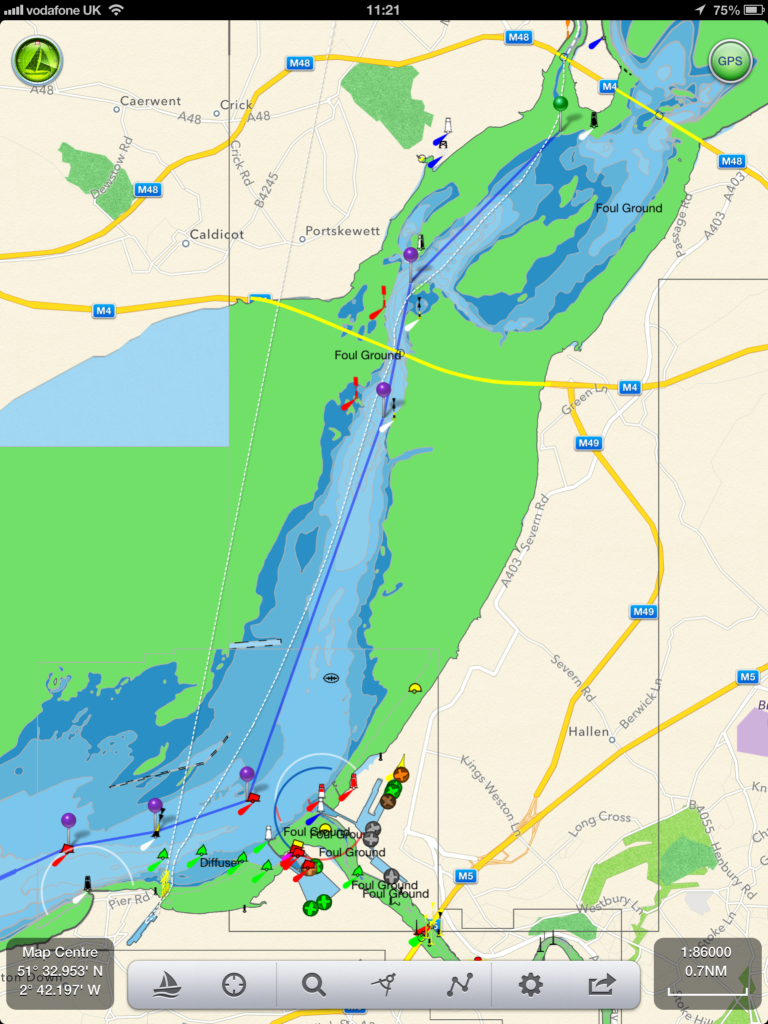
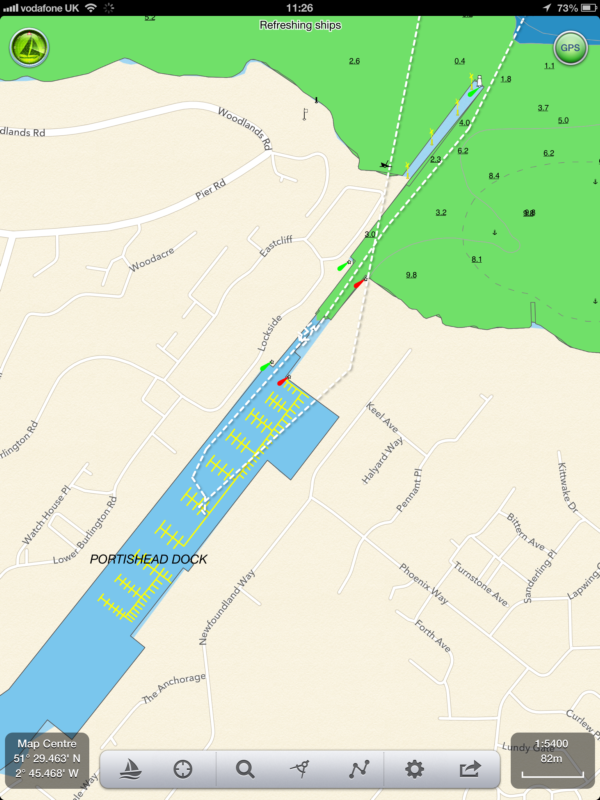
We have now launched our new Boat Beacon companion app, Boat Watch.
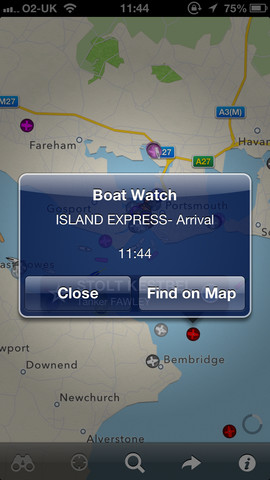
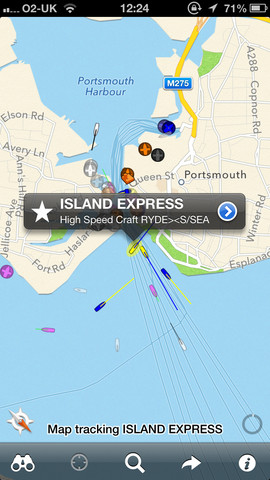
Boat Watch is a free app, which offers…
* Spot any Boat or Ship via real-time AIS
* See the Name, Type and Destination of each vessel
* Set any boat as your favoirite, and automatically track it on the map
* Search and find boats and places
* Share boats on Facebook, Twitter or by email
Optional One-time In-App Upgrade Purchase adds…
* Get alerts when your favourite boat arrives or departs
* Full boat information – speed, course, country, etc.
For Boat Beacon users, Boat Watch is a great app to tell your friends and family about so they can follow your voyage.
Boat Watch is a Universal app, which works on iPhone, iPod and iPad.
As part of the Boat Watch launch we are sponsoring the Ahoy Centre Totally Oarsome! charity – which challenges you to test your abilities, get fit and raise money for the Ahoy charity to help others.
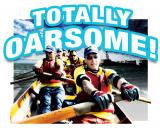
Let your family , fr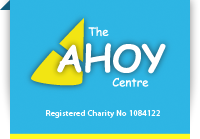 iends and supporters follow you in real time on their iPhone, iPad or iPod as you take on AHOY’s ultimate rowing challenge.
iends and supporters follow you in real time on their iPhone, iPad or iPod as you take on AHOY’s ultimate rowing challenge.
Pocket Mariner are sponsoring the Ahoy Centre by providing every rowing team with a free copy of their Boat Beacon AIS tracking app. All you need to do is enter your team name in the boat details, then invite your family, friends and supporters to follow you in the FREE Boat Watch app. Tap the Sail button in Boat Beacon to start tracking. Boat watchers will be able to see your position and track updated continuously as well as all the other boats around you. See the screen-shots above for an idea of what you can see on the Boat Watch app.
With the Boat Watch In-App purchase option for only £1.99, family, friends and supporters are able to monitor your speed, course, destination and ETA details. They also get automatic alerts on their iPhone, iPad or iPod when you start and finish or stop midway!
All proceeds from the In-App purchases during the challenge will go to the AHOY Centre.
We had some great feedback from one of our users, Ken, in Southern California:-
I have now been using Boat Beacon in the southern California waters for the past few months and really enjoy the visibility it provides me. Just this past weekend, my Yacht Club had a large cruise over the 4th in Catalina and in my trip over, I had a cargo ship that, based on Boat Beacon CPA data, going to get really close. I called the ship, by name, on VHF Channel 16 and based on the conversation, he changed course, which again we had a conversation with him telling me what he had planned to do etc.
It is exactly that type of data that made my trip along with a lot of others.
My question is; I have an assigned MMSI and Transmitting from the iPad, I “see” the ships, do they “see” me on their shipboard system? I know I can be seen on ship finder, Marine Traffic, but not sure if they see me in real time on their system.
BTW; a number of my club members who were in transit had heard my call and discussion and came away impressed with what Boat Beacon can do. A number of them have already downloaded it onto their apple IOS and Android devices.
In answer to Ken’s question, if you are only transmitting your position using Boat Beacon then the ships will not be able to see you on their VHF AIS Systems. However many of the Coast Guard stations and Harbour/Port Authorities around the US, UK and Australia do now combine internet AIS feeds with their local VHF AIS data, so there is a good chance you will be showing up on their screens.
Check out the pictures these guys are posting on their Twitter feed…
https://twitter.com/
Sheerness Lifeboat!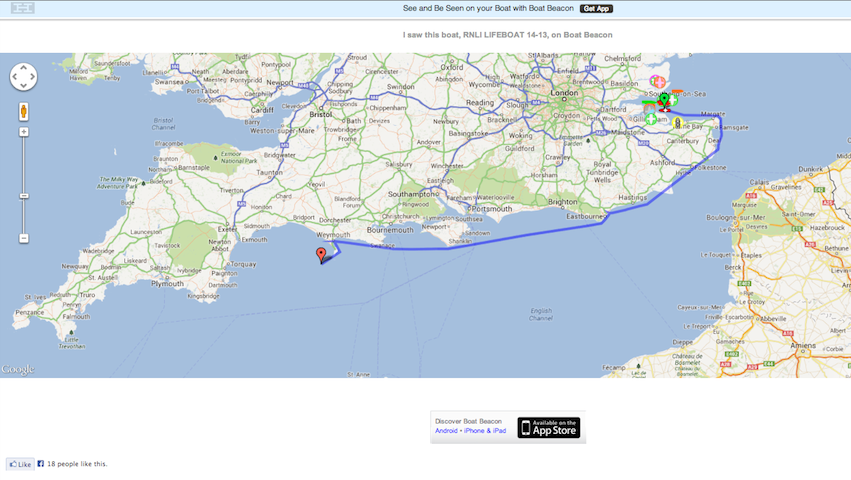
Wales, UK – Pocket Mariner’s recently launched SeaNav app, with versions for both the US and UK/Ireland, has been updated to offer a more complete charting and navigation toolkit for boaters. To improve navigation and collision avoidance when out of reach of cell phone coverage, SeaNav — together with Pocket Mariner’s Boat Beacon app — can now also use on-board live VHF AIS data feeds. The app also now enables sailors to jump directly to specific locations using latitude and longitude searches and has been extended for use on iPods as well as iPhone and iPad.
SeaNav was designed to enable boaters to explore, plan and navigate their boating trips in real-time and high-resolution using the latest up to date Digital Vector Marine charts covering the US coastlines and Great Lakes or the UK and Ireland. Pocket Mariner has successfully completed sea trials of the new local AIS feature with Lowrance, Simrad and B&G’s GoFree™ wireless systems, as well as with easyAIS and Digital Yacht.
Robert Langford-Wood Product Manager for GoFree Technology said: “Applications such as SeaNav and Boat Beacon, when combined with GoFree wireless, allow boaters to make the most out of their Lowrance, Simrad and B&G chartplotters and AIS systems away from the helm. It means that every member of the crew can have a navigator’s eye view, increasing safety and enjoyment out on the water – a great innovation!”
SeaNav works best when paired with Pocket Mariner’s Boat Beacon, which has become an enormously popular app among sailors for its simple-to-use location sharing and real-time “Map View” of both the user’s and other nearby boats via AIS. Together, SeaNav and Boat Beacon provide a powerful set of charting, navigation and location-sharing tools. While Boat Beacon provides SeaNav with its AIS data and alarms, Boat Beacon gets marine charts and routes from SeaNav. The two apps share hot-jump buttons that ensure they are both on the same location and at the same zoom level on the map.
Key features of SeaNav include:
• Route Planning and real time tracking including Waypoints, SOG, COG, ETA, CTE etc.
• Route and Track export, import and sharing.
• Charts downloaded and stored on device so they work without mobile coverage!
• Seamless fast panning and zooming across charts.
• Live AIS Ship positions overlaid from Pocket Mariner’s Boat Beacon app.
• Configurable layers; buoys, lights, depths, rocks, wrecks, anchorage areas etc.
• Automatic Chart updates.
SeaNav has two versions, SeaNav US which uses NOAA charts providing complete coverage of USA and Great Lakes and free chart updates for life. SeaNav UK uses UKHO Admiralty charts and includes the complete set of charts for the UK and Ireland plus a year of free chart updates in the one-off price. New versions of the app with charts for other countries and regions are in the works.
Both versions are available from the App Store for iPhone, iPad, and – in this latest version – on an iPod touch, for US$9.99 and £9.99 in the UK.
For more information, visit PocketMariner.com. or email steve@pocketmariner.com
Live screenshots testing Boat Beacon in the Solent
Our test boat!
Live view from Boat Beacon: the test boat is the purple boat in the centre, while the Ferry is blue to port
View of the blue target (Ferry) from bridge of our boat.
About Navico: Navico is currently the world’s largest marine electronics company, and is producing products under leading marine electronics brands: Lowrance, Simrad and B&G. Navico has approximately 1,500 employees globally and distribution in more than 100 countries worldwide. www.navico.com
We were asked if we could help out with a new Australian Coast Guard radio log system using Boat Beacon. The system is now live and made it onto Australian TV.
Boat Beacon being used with the Australian Coast Guard.
N.B. The clip where they accredited Pocket Mariner with making Boat Beacon is on the cutting room floor unfortunately – you have to love reporters 🙂
Captain Ian Engelbrecht and First Mate Ibolya Palko from Worldwide Yacht Deliveries sent us a report today on how Boat Beacon helped them when they were caught in fog 4NM off the South African coast. They were sailing a Jaguar 36 Catamaran on a 900 mile, 12 day voyage from Cape Town to Durban, South Africa. There is a map showing their planned route to the right. They had just passed Hamburg on their route up the East South African coast when they lost visibility. Their primary AIS system had failed. They did the right thing and diverted in close to shore to find shallow waters and avoid any commercial shipping (see the track map below). They were hoping there wouldn’t be anything else so close in. They decided to power up Boat Beacon on their Android smartphone and leave it running to keep a look out.
Boat Beacon alerted them to a container ship, also close in, going in the opposite direction! At a range of 21 NM ( well over the normal VHF AIS horizon) Boat Beacon gave them plenty of time to assess the situation and take the necessary avoiding action.
They also had some very useful feedback. Having no visibility and due to the specific courses involved, they weren’t too sure on how the Closest Point of Approach (CPA) would pan out. In other words what would the CPA be in relation to their vessel – port or starboard? That made it difficult to decide on the correct avoiding action to take. Captain Iain Engelbrecht asked if we could add a new feature to Boat Beacon to give the bearing of the closest point of approach with respect to one’s own boat (e.g. 0° is dead ahead, 90° to starboard, 270° is to port etc.).
Captain Engelbrecht was impressed by Boat Beacon’s real time performance – that may have saved their lives – and our immediate response to his suggestion. We are now adding the new CPA Bearing feature, continuing Pocket Mariner’s commitment to providing useful, professional and affordable aids to navigation and safety.
BoatU.S. have reviewed Boat Beacon and lists it first of the 4 Best Apps To Keep You Safe On The Water
We popped down to the Southampton Boat Show to share our wares and look for new App ideas. We also got a chance to take Boat Beacon out for a spin on a $1M Speed boat and test at high speed!
Here are some real time screen shots from the boat and of Boat Beacon’s display. All lined up in real time perfectly. We are on the purple boat in the centre of the screenshot doing just over 20Kts overtaking Red Falcon which is to port.
We met up with Yachting Monthly Editor, Keiran Flatt and he is going to publish our Marine Apps survey on-line and in the next print edition and he also had some ideas for new Marine Apps he would like to see. He is thinking of setting up a photo shoot and story about our company with a trip down the Wye to the Severn from our offices on Sarita.
A fantastic day and some great new ideas and opportunites for Boat Beacon and for some new Apps.